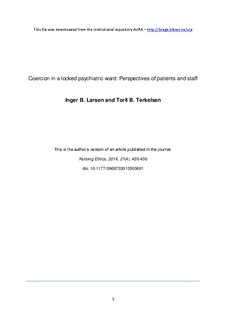| dc.contributor.author | Larsen, Inger Beate | |
| dc.contributor.author | Terkelsen, Toril Borch | |
| dc.date.accessioned | 2015-03-17T10:44:02Z | |
| dc.date.available | 2015-03-17T10:44:02Z | |
| dc.date.issued | 2014 | |
| dc.identifier.citation | Larsen, I. B., & Terkelsen, T. B. (2014). Coercion in a locked psychiatric ward: Perspectives of patients and staff. Nursing Ethics, 21(4), 426-436. doi: 10.1177/0969733013503601 | nb_NO |
| dc.identifier.issn | 1477-0989 | |
| dc.identifier.uri | http://hdl.handle.net/11250/279463 | |
| dc.description | Author's version of an article in the journal: Nursing Ethics. Also available from the publisher at: http://dx.doi.org/10.1177/0969733013503601 | nb_NO |
| dc.description.abstract | Background: In spite of a national strategy for reducing coercion in the mental health services, Norwaystill has a high rate of involuntary treatment compared to other European countries. It is therefore crucial tostudy various parties involved in involuntary treatment in order to reduce coercion.Research question: How do patients and staff in a Norwegian locked psychiatric ward experiencecoercion? Research design: Participant observation and interviews.Participants: A total of 12 patients and 22 employees participated in this study.Ethical considerations: This study is accepted by the National Committee for Medical Health ResearchEthics.Findings: The participants experienced coercion in different ways. Patients often felt inferior, while manyof the staff felt guilty for violating patients' dignity, although they ascribed responsibility for their actions tothe "system." The main themes are (1) corrections and house rules, (2) coercion is perceived as necessary,(3) the significance of material surroundings, and (4) being treated as a human being.Discussion: The discussion draws upon the concepts of vulnerability, guilty conscience, and ethicalsensitivity, related to the staffs' divergent views on coercion.Conclusion: Especially among staff, there are divergent views of coercion. Professionals being physicallyand emotionally close to the patient are more likely to understand him or her as a unique person withindividual needs. If patients are kept at a distance, professionals as a group change to understand patientsas members of a group with common needs and common restrictions. | nb_NO |
| dc.language.iso | eng | nb_NO |
| dc.publisher | Sage Publications | nb_NO |
| dc.subject | coercion | nb_NO |
| dc.subject | ethical sensitivity | nb_NO |
| dc.subject | experiences of staff and patients | nb_NO |
| dc.subject | forced treatment | nb_NO |
| dc.subject | locked psychiatric ward | nb_NO |
| dc.subject | seclusion | nb_NO |
| dc.subject | vulnerability | nb_NO |
| dc.title | Coercion in a locked psychiatric ward: Perspectives of patients and staff | nb_NO |
| dc.type | Journal article | nb_NO |
| dc.type | Peer reviewed | nb_NO |
| dc.subject.nsi | VDP::Medical disciplines: 700::Health sciences: 800::Nursing science: 808 | nb_NO |
| dc.source.pagenumber | 426-436 | nb_NO |
| dc.source.volume | 21 | nb_NO |
| dc.source.journal | Nursing Ethics | nb_NO |
| dc.source.issue | 5 | nb_NO |
| dc.identifier.doi | 10.1177/0969733013503601 | |
